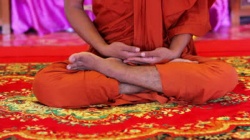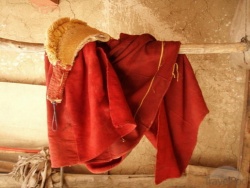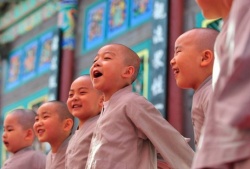The Sangha: the third of the Three Refuge
What is the Sangha?
The Sangha is the order of ordained Buddhist monks (bhikkhus) and nuns (bhikkhunis), founded by the Buddha over 2500 years ago.
Why did the Buddha establish it?
To provide a means for those who wish to practise the Dhamma full time, in a direct and highly disciplined way, free from many of the restrictions and responsibilities of the household life. The Sangha also fulfils the function of preserving the Buddha’s original teachings and of providing spiritual support for the Buddhist lay-community.
What is the relationship between the Sangha and the Buddhist lay-community?
It is one of reciprocal support. The Buddha ensured that his monks and nuns maintain daily contact with the laity by forbidding them to keep money and to store, grow, cook, or procure in any way their own food. Thus monks and nuns depend on the laity for material support. On the other hand, the laity depend on the Sangha for inspiration and guidance in matters concerning the Dhamma. “Monks, householders are very helpful to you, as they provide you with the requisites of robes, almsfood, lodgings, and medicine. And you, monks, are very helpful to householders, as you teach them the Dhamma admirable in the beginning, in the middle, and in the end. In this way the holy life is lived in mutual dependence, for the purpose of crossing over the flood, for making an end to suffering.” (Iti. 107)
How is the life of a member of the Sangha different from that of a lay-Buddhist?
The most significant difference is that a monk must live according to the Vinaya – the body of rules laid down by the Buddha. This code of conduct dictates in great detail how a monk is to live his life. At the heart of the Vinaya lies the Patimokkha – the set of 227 precepts. The rules of the Patimokkha are graded from heavy to light: the breaking of the heaviest (of which there are four) entails expulsion from the Sangha; the breaking of the lightest results in a short confession.
Why did the Buddha lay down the Vinaya?
He was asked this question and gave ten reasons: “For the welfare of the Sangha, for the comfort of the Sangha, for the control of unsteady men, for the comfort of well behaved bhikkhus, for the restraint of the pollutions of this present life, for guarding against pollutions liable to arise in a future life, for the pleasure of those not yet pleased with Dhamma, for the increase of those pleased, for the establishment of true Dhamma, for the benefit of the Vinaya.” (AN. v.70. *)
A recent development
During the 2500 years following the Buddha’s passing, across all legitimate schools of Buddhism, the term Sangha referred to the order of monks and nuns. However, in the West, in the past 60 years or so, the term has come to include not only all Buddhist people – ordained and lay, but sometimes even those who attend Buddhist meditation classes who have not actually taken refuge in the Triple Gem themselves. So misappropriated has this term become that we now find the likes of the ‘Buddhist Military Sangha’!!!
Being deeply ingrained in Western Buddhism it is hard to see this aberration being rectified. So for those of us who do know the correct meaning of the term Sangha, we should strive to preserve it, and with it the Triple Gem.
From Bhikkhu Bodhi:
‘The Sangha — the order of fully ordained monks and nuns — is the visible representation of the Buddha in the world; for twenty-five centuries, it has sustained the continuity of the Dharma among humankind; by its procedures of ordination and transmission it ensures that the Buddha’s legacy remains alive. The presence of the Triple Gem thus depends upon the Sangha, which symbolizes the Third Gem, the ariyan Sangha or community of noble sages who have realized the ultimate, world-transcending truth. The Sangha has survived for some 2500 years: that’s longer than the Roman Empire, longer than all the dynasties of the Chinese emperors, longer than the British Empire. And it has survived without weapons, without financial resources, without armies, merely through the power of wisdom and virtue. However, there is no guarantee that it will continue to survive or that it will continue to make vital and important contributions to human life. This is a task that depends on the members of the Sangha themselves, on each new generation of monks and nuns, and this is an extremely important task, because the future of Buddhism depends on the future of the Sangha.’


